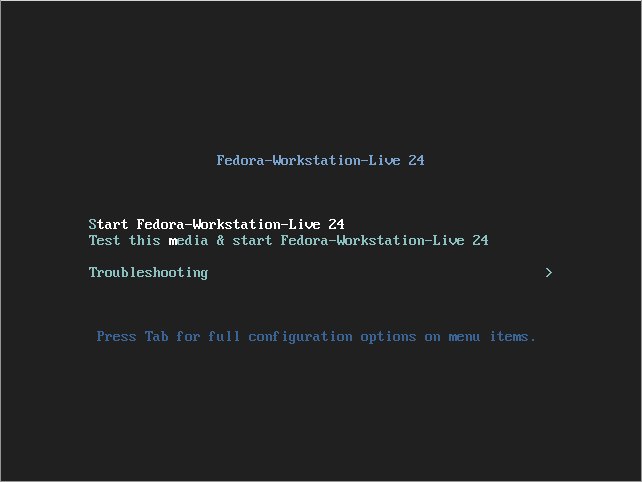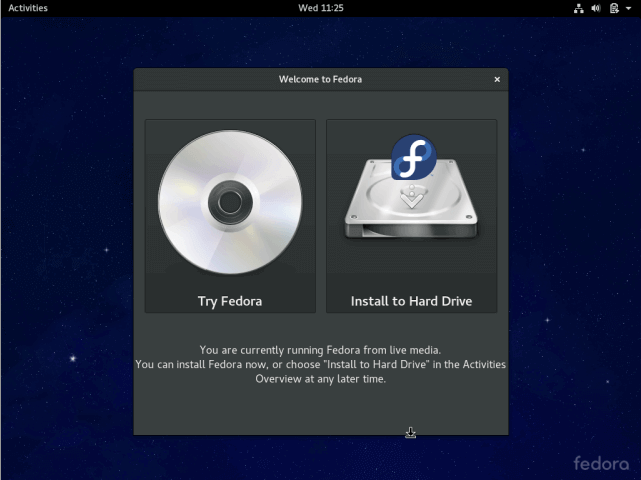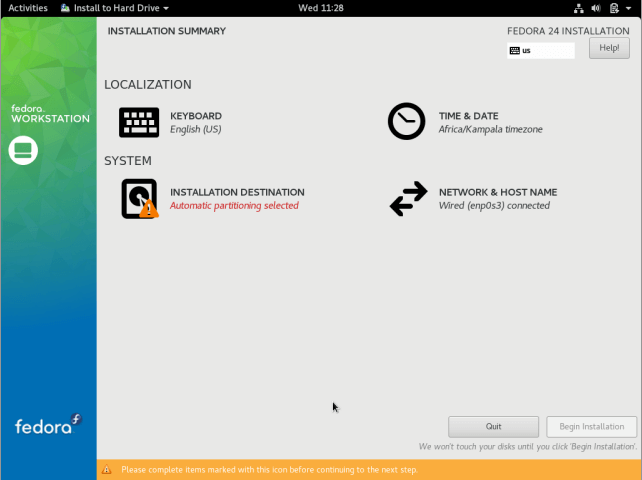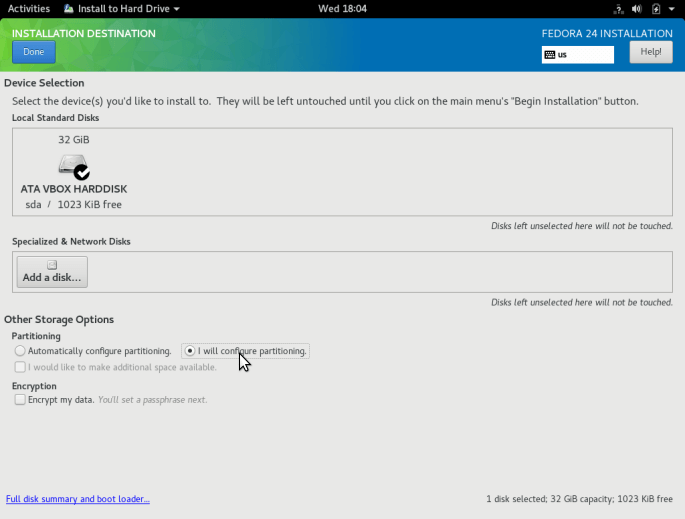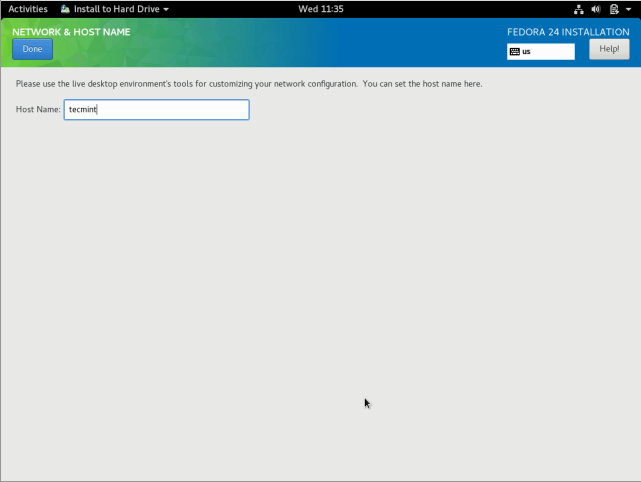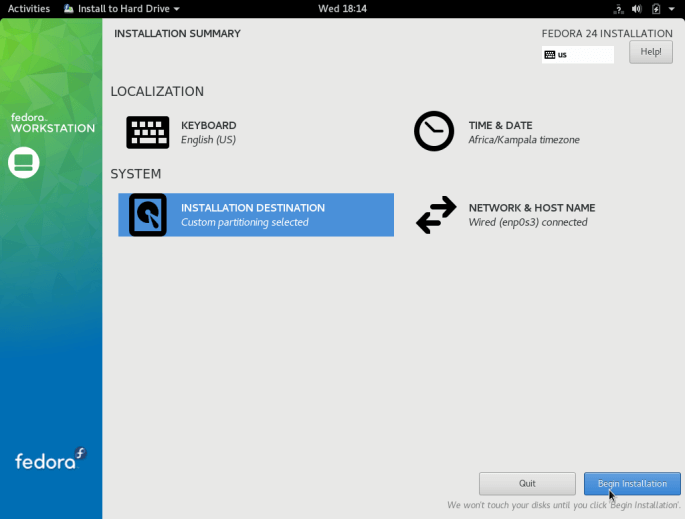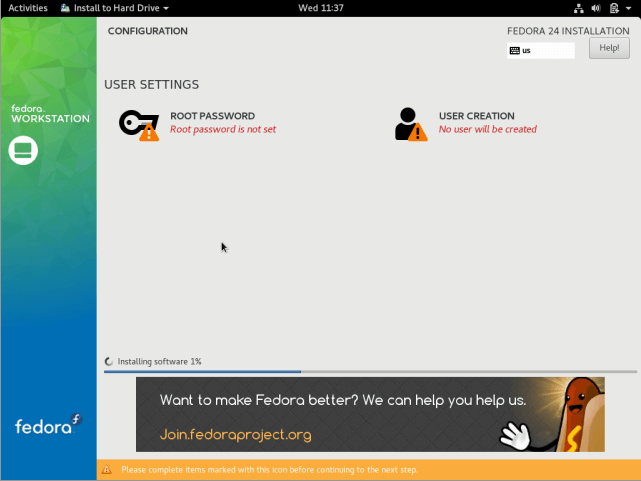Insert DVD and reboot.
- Select "Install to Hard Drive"
- Select "Installation destination"
- Select a device, "Automatically configure partitioning", and "I would like to make additional space available".
- Go back to "Installation Summary" and select "Network and Host Name"
- Give a host name
- Select "Begin Installation" to continue.
- As the system files are being installed, setup root password and setup user.
- Once installation is completed, remove the media and reboot
- dnf update to update installed packages
- Reboot
- vi /etc/sysconfig/selinux to "disabled"
- Stop & disable firewalld.service unless you want to use firewall
- If you need to use NIS in OpenTV:
- dnf install ypbind rpcbind
- /etc/nfsmount.conf
- ypdomainname hq.k.grp
- /etc/sysconfig/authconfig
- /etc/yp.conf
- domain hq.k.grp server 10.4.50.16
- domain hq.k.grp server 10.4.50.17
- /etc/nsswitch.conf
- passwd: add nis
- shadow: comment out
- group: add nis
- netgroup: nis sss
- automount: files nis sss
- systemctl enable rpcbind ypbind and reboot
- autofs
- dnf install autofs
- /etc/sysconfig/autofs
- /etc/auto.master
- /etc/resolv.conf
- search hq.k.grp
- nameserver 10.4.40.7
- nameserver 10.4.20.46
- systemctl enable & start autofs.service
- samba
- dnf install samba
- vi /etc/samba/smb.conf
[global]
server string = yjpark_linux
security = user
[homes]
comment = Home Directories
valid users = %S, %D%w%S
browseable = Yes
writable = yes
inherit acls = Yes
- To export other than user home directory, e.g. /home/yjpark:
- systemctl smb restart
- smbpasswd -a user_id
- If firewalld is enabled:
- firewall-cmd --permanent --add-service=samba
- service firewalld restart
- Apach
- systemctl enable/start httpd.service
- default html documents are in /var/www/html
- Docker CE
- dnf install dnf-plugins-core
- dnf config-manager --add-repo https://download.docker.com/linux/fedora/docker-ce.repo
- dnf install docker-ce
- Add user to docker
- groupadd docker
- gpasswd -a yjpark docker
- usermod -aG docker yjpark
- docker-compose upgrade
- curl -L https://github.com/docker/compose/releases/download/1.17.0/docker-compose-`uname -s`-`uname -m` -o /usr/local/bin/docker-compose
- replace /usr/bin/docker-compose
- docker registry
- docker pull registry:2
- docker run -d -p 5000:5000 --restart always --name registry registry:2
- vi /etc/docker/daemon.json
{
}
- systemctl restart docker
- push docker image
FROM ubuntu:12.04
CMD while true; do echo 'Hit CTRL+C'; sleep 1; done
- docker build -t docker_test_1 .
- docker run --rm -it docker_test_1
- docker tag docker_test_1 10.0.0.211:5000/docker_test_1
- docker push 10.0.0.211:5000/docker_test_1
- pull docker image
- vi /etc/docker/daemon.json
{
"insecure-registries":["10.0.0.211:5000"]
INSECURE_REGISTRY='--insecure-registry 10.0.0.211:5000'
- systemctl restart docker
- docker pull 10.0.0.211:5000/docker_test_1
- docker tag 10.0.0.211:5000/docker_test_1 docker_test_1
- lookup
- curl 'http://10.0.0.211:5000/v2/_catalog'
- stop registry
- cleanup registry
- docker swarm
- docker swarm init --listen-addr 0.0.0.0:2377 --advertise-addr 10.0.0.211
- docker swarm join-token manager
- docker swarm join-token worker
- docker swarm join --manager --listen-addr 0.0.0.0:2377 10.0.0.211:2377
- In different machine, docker swarm join --token SWMTKN-1-28hbo372s2s7vqksqu95xjka1tlq2u44cyzxeu7nkp510nfhbs-0qcw90bwph9vph3pmg45wqbfi 10.0.0.211:2377
- docker node ls
- docker node update --label-add nodelabel=ubuntu dqviprkfsjriozb7a37n5ccvt
- docker node inspect dqviprkfsjriozb7a37n5ccvt
- docker service create --replicas 2 --detach=false --name docker_test 10.0.0.211:5000/docker_test_1
- docker service ls
ID NAME MODE REPLICAS IMAGE PORTS
o29rus4yn3m5 docker_test replicated 2/2 10.0.0.211:5000/docker_test_1:latest
- docker service ps o29rus4yn3m5
ID NAME IMAGE NODE DESIRED STATE CURRENT STATE ERROR PORTS
a5ea1hinp1s6 docker_test.1 10.0.0.211:5000/docker_test_1:latest yjpark-linux-01 Running Running 2 minutes ago
ce41xdqa9ef5 docker_test.2 10.0.0.211:5000/docker_test_1:latest Ubuntu-VirtualBox Running Running 2 minutes ago
- docker service logs a5ea1hinp1s6
- docker service scale docker_test=1
- docker service rm o29rus4yn3m5
- virtualbox
- download https://www.virtualbox.org/wiki/Download_Old_Builds_5_1
- dnf install kernel-devel
- /sbin/vboxconfig
- Download ubuntu iso file
- Create new vm
- Perforce
- download p4d from https://www.perforce.com/downloads/helix-versioning-engine-p4d
- vi /etc/systemd/system/p4d.service
# Example Perforce systemd file (p4d.service):
#
# This service file will start Perforce at boot, and
# provide everything needed to use systemctl to control
# the Perforce server process.
[Unit]
# Note that descriptions are limited to 80 characters:
Description=Perforce Server
# Starts Perforce only after the network services are
# ready:
#After=network.target
After=network-online.target
[Service]
# The type should always be set to "forking" to support
# multiple Perforce processes:
Type=forking
# Set the system user used to launch this process (usually
# 'perforce':
User=perforce
# The command used to start Perforce:
ExecStart=/usr/bin/p4d -r /home/yjpark/p4d/p4d -p 10.0.0.211:1666 -d
[Install]
# Describes the target for this service -- this will always
# be 'multi-user.target':
WantedBy=multi-user.target
- systemctrl start p4d
- systemctl enable p4d
- a symbolic link to p4d.service file will be created in /etc/systemd/system/multi-user.target.wants
- download p4v from https://www.perforce.com/downloads/helix-visual-client-p4v
- create a symbolic link to p4v in /usr/local/bin.
- git
- git user:
- ssh-keygen -t rsa -b 2048
- sudo adduser git
- cd /home/git
- su git
- mkdir git-shell-commands
- sudo vi /etc/passwd, change bash to git-shell
- sudo -u git -s
- mkdir .ssh
- chmod 700 .ssh
- cat ./id_rsa.pub >> ./authorized_keys
- chmod 600 ./authorized_keys
- rm -rf ./id_rsa.pub
- cd /home/git
- mkdir repos
- cd repos
- mkdir test_project.git
- cd test_project.git
- git init --bare --shared
- user:
- git config --global user.name "yjpark"
- git config --global user.email "yongjin.park.kr@gmail.com"
- cd git/workspace
- git clone ssh://git@10.0.0.211:/home/git/repos/test_project.git
- cd test_projec
- vi test.py
- git add .
- git status
- git commit -a -m "initial commit"
- git push origin master
- git status
- Jenkins
- In the staging server:
- Setup staging Jenkins server and install plugins
- curl -sSL "http://user:pass@10.0.0.211:8080/pluginManager/api/xml?depth=1&xpath=/*/*/shortName|/*/*/version&wrapper=plugins" | perl -pe 's/.*?<shortName>([\w-]+).*?<version>([^<]+)()(<\/\w+>)+/\1 \2\n/g'|sed 's/ /:/' > plugins.txt
- In the target server (VM), using a Jenkins job:
- sync workspace in Perforce, e.g. /home/perforce/workspace/jenkins/, which has a Dockerfile and plugins.txt (see above) in it
- Dockerfile example:
FROM jenkins/jenkins
COPY plugins.txt /usr/share/jenkins/ref/plugins.txt
RUN /usr/local/bin/install-plugins.sh < /usr/share/jenkins/ref/plugins.txt
- mkdir /home/jk
- docker build -t 10.0.0.211:5000/jenkins .
- docker push 10.0.0.211:5000/jenkins
- docker run -p 8090:8080 -p 50000:50000 -v /home/jk:/var/jenkins_home 10.0.0.211:5000/jenkins
